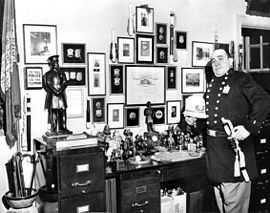Jay Irving

Irving Joel Rafsky (October 3, 1900 - June 4, 1970), known as Jay Irving, was a cartoonist notable for his syndicated strip Pottsy about a good-natured, dutiful New York police officer, Pottsy, who sometimes came in conflict with his sergeant.
Born in New York, Irving became familiar with police activities at an early age, since his father, Abraham Rafsky, was a captain in the New York Police Department. After attending Columbia University, Irving was employed as an insurance salesman and a police reporter for the New York Globe.[1]
Cartoons
A self-taught artist, Irving became a sports cartoonist in the late 1920s. He drew the strip Bozo Blimp for King Features Syndicate and spent two years doing advertising art. Dorothy Prago and Jay Irving married in 1922, and their only child, Clifford Irving, was born November 5, 1930. Clifford Irving said about his father, "I think he felt two things: He felt that he didn’t want the family to know, and he also felt there was a certain level of anti-Semitism in the cartoon business." Irving continued, "My father kept it secret from the family. He drew under his name Jay Irving, which was extrapolated from his name. Then, when he became successful, he confessed and changed his name legally."[2]
In 1932, Irving began a 13-year association with Collier's, drawing the weekly cartoon panel Collier's Cops. He also did covers for Collier's, including one for the October 26, 1940 issue.
In 1946, he created the short-lived comic strip Willie Doodle, also about a police officer, for the Herald-Tribune Syndicate.[1]
Pottsy
His Pottsy strip was syndicated by the Tribune-News Syndicate from 1955 until 1970.[1] Irving's son, Clifford, was an art student in the mid-1940s at the High School of Music & Art, and he assisted his father by doing lettering on both Willie Doodle and Pottsy.[3] Clifford Irving later wrote about the art world in his book Fake! The Story of Elmyr de Hory, the Greatest Art Forger of Our Time (1969).
The word "Pottsy" entered the language during the run of the strip. A police officer who prevented the loss of his badge by wearing a fake badge referred to the fake as a Pottsy. Later, these fake badges became known as "dupes".[4]
Television
Irving and Mel Casson were regular performers on the ABC television series Draw Me a Laugh (1949), produced by Casson. The show was hosted by Patricia Bright and Walter Hurley. Guest cartoonists included Gus Edson. Viewers sent in ideas which were drawn by the cartoonists while members of the studio audience constructed the gag lines. Folk singer Oscar Brand then vocalized the "singing captions".[5]
Irving was 69 when he died of a heart attack in his New York apartment at 650 West End Avenue. His wife Dorothy survived him by less than a year. He was also survived by his son, the novelist Clifford Irving; a brother, John F. Norman; and two sisters, Mrs. Bebe Hamilburg and Mrs. Milton N. Rosenthal.[1]
National Cartoonists Society
Irving was a founding member of the National Cartoonists Society, although his name is curiously absent from the organization's online roster of members.[6] He was the official historian for the Police Department's Honor Legion, and he owned a collection of police memorabilia dating back more than 300 years. His collection included dozens of photographs of law enforcement officers, including some photos from the 19th century.[1]
Clifford Irving used his father's art supplies to create forgeries necessary for his 1971 hoax autobiography of Howard Hughes.[3]
References
- ↑ 1.0 1.1 1.2 1.3 1.4 "Jay Irving, 69, Drew Comic Strip Pottsy". The New York Times, June 5, 1970.
- ↑ The Thin Black Line: Jay Irving and His Cartoon Cops, Hogan's Alley, 2010
- ↑ 3.0 3.1 Irving, Clifford. The Hoax
- ↑ Rivera, Ray. "The Officer Is Real; The Badge May Be an Impostor". The New York Times, November 30, 2009.
- ↑ Jay Irving Web Extras
- ↑ National Cartoonists Society